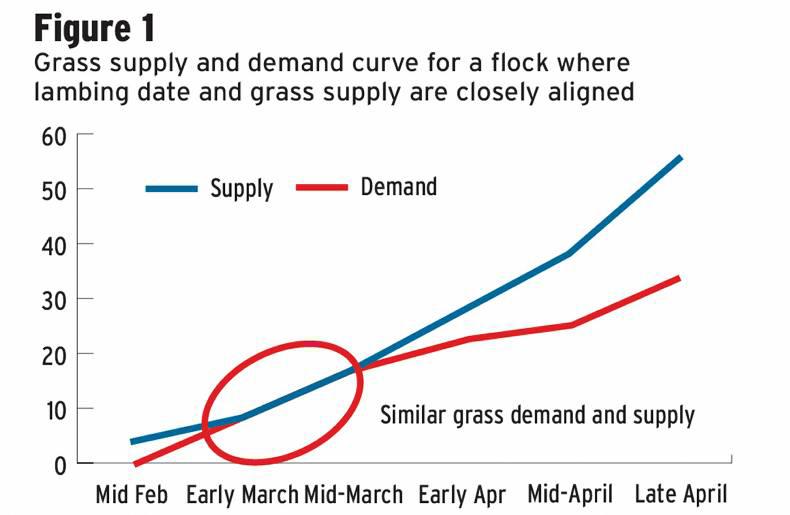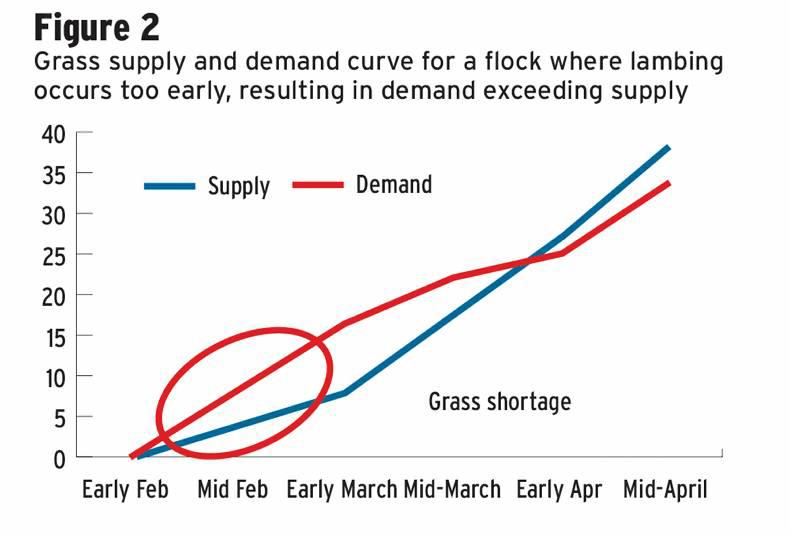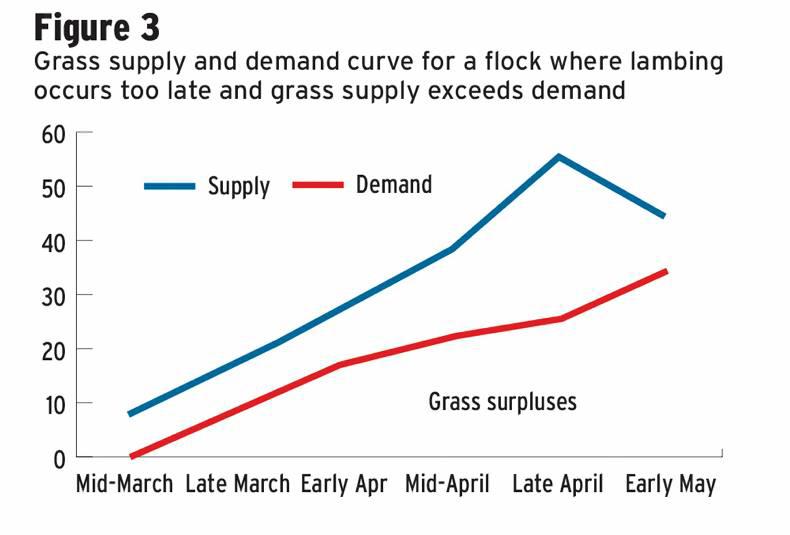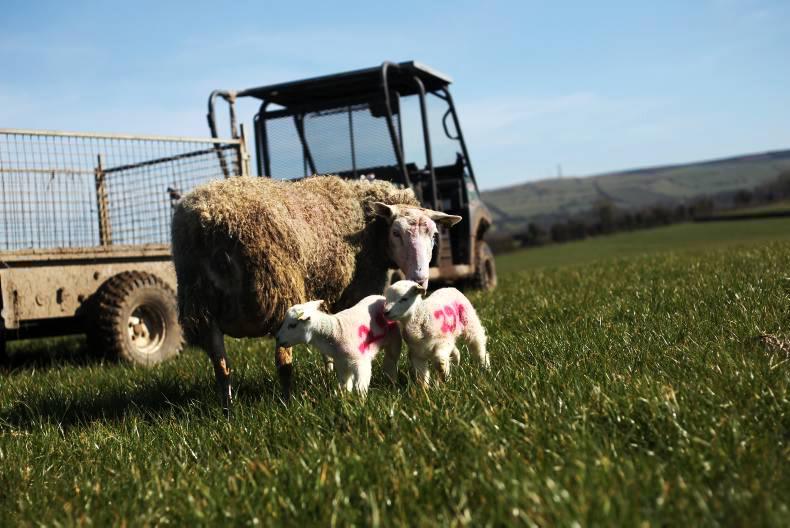With the breeding season just around the corner, it’s time to start looking ahead to next spring and lambing time.
This will start the clock on next year’s production season and the timing of ram turn-out will affect flock performance throughout the production season.
For mid-season systems, the aim should be to achieve high levels of animal performance in a cost-effective manner.
One of the major challenges on farms each spring is to have sufficient grass available for ewes and their lambs immediately after lambing. Matching lambing date to grass supply will ensure high levels of performance for your flock and reduce or eliminate the need for concentrate supplementation.
To achieve this requires planning from now onwards so that rams are let out at the correct time and paddocks grazed out and closed up in time for the following spring.
Separately
As spring grass growth will vary across the country, it is important that each farm be considered separately and align lambing date with grass availability. Ideally, if grass is being measured regularly there will be a bank of information available from past years to assist in making decisions.
The experience from the Teagasc BETTER sheep farms shows the benefits of lambing ewes to match grass supply.
As with most lowland flocks, the target on these farms is letting ewes and lambs out to grass within 24-48 hours of lambing, weather permitting.
On these farms, grass growth is monitored throughout the year and this data is used to plan when rams are joined to the flock in order to lamb to match grass supply.
Figures 1, 2 and 3 show the grass growth and ewe demand for three different scenarios – lambing at the correct time to match grass supplies, too early and too late.

The grass supply curve and lambing dates used in Figure 1 (ideal lambing time) are taken from one of the BETTER sheep farm’s 2016 records.
These lambing dates were then moved backwards and forwards by two weeks in order to see how this affected grass supply available to the freshly lambed ewes.

Figure 2 shows when lambing is too early and there is not sufficient grass to match demands. This will mean that concentrate supplementation will be necessary in order to meet ewe demands but also that rotation length will be too quick, negatively affecting grassland management and flock performance (particularly lamb growth rates).

In Figure 3, lambing date is too late in comparison to the grass growth curve, meaning surpluses build up in early spring. This reduces grass quality, makes management harder and also potentially reduces sward quality for the remainder of the grazing season. For most flocks, this will mean lambing sometime in mid- to late March providing a correct winter closing plan has been put in place.
The benefits of this are also clear to see from the work being carried out by Dr Philip Creighton on the Teagasc Athenry Research and Demonstration Flock.
A winter closing plan begins in autumn so that grazing is planned to allow paddocks to be closed in order of their requirement during the spring, ie close off sheltered paddocks first. Paddocks should be closed for 120 days prior to target spring turnout date in order to allow grass cover build up for the following spring.
Rotation
For a flock lambing from mid-March onwards, this would mean closing paddocks in rotation from mid-November onwards, with rams turned out in mid-October. Grass growth will be lower than grass demand initially in the spring so grass covers need to be built from the previous autumn. Grass growth should match and exceed demand from approximately one month after lambing, at which point paddocks can be dropped from the rotation for silage.
However, the first step in all of this is to ensure that breeding is timed correctly in order to lamb at the right time for your farm. The use of teaser rams, etc, to reduce lambing spread will also aid spring management and needs to begin approximately three weeks before introduction of fertile rams to the flock.
For mid-season flocks: Lambing date needs to match grass supply.Assess your own farm situation and where available, use grass growth records or experience from previous years to assist in making decisions.Ram turnout date needs to be planned to ensure lambing is not too late or too early to match grass supply. Read the full focus section on sheep breeding here
With the breeding season just around the corner, it’s time to start looking ahead to next spring and lambing time.
This will start the clock on next year’s production season and the timing of ram turn-out will affect flock performance throughout the production season.
For mid-season systems, the aim should be to achieve high levels of animal performance in a cost-effective manner.
One of the major challenges on farms each spring is to have sufficient grass available for ewes and their lambs immediately after lambing. Matching lambing date to grass supply will ensure high levels of performance for your flock and reduce or eliminate the need for concentrate supplementation.
To achieve this requires planning from now onwards so that rams are let out at the correct time and paddocks grazed out and closed up in time for the following spring.
Separately
As spring grass growth will vary across the country, it is important that each farm be considered separately and align lambing date with grass availability. Ideally, if grass is being measured regularly there will be a bank of information available from past years to assist in making decisions.
The experience from the Teagasc BETTER sheep farms shows the benefits of lambing ewes to match grass supply.
As with most lowland flocks, the target on these farms is letting ewes and lambs out to grass within 24-48 hours of lambing, weather permitting.
On these farms, grass growth is monitored throughout the year and this data is used to plan when rams are joined to the flock in order to lamb to match grass supply.
Figures 1, 2 and 3 show the grass growth and ewe demand for three different scenarios – lambing at the correct time to match grass supplies, too early and too late.

The grass supply curve and lambing dates used in Figure 1 (ideal lambing time) are taken from one of the BETTER sheep farm’s 2016 records.
These lambing dates were then moved backwards and forwards by two weeks in order to see how this affected grass supply available to the freshly lambed ewes.

Figure 2 shows when lambing is too early and there is not sufficient grass to match demands. This will mean that concentrate supplementation will be necessary in order to meet ewe demands but also that rotation length will be too quick, negatively affecting grassland management and flock performance (particularly lamb growth rates).

In Figure 3, lambing date is too late in comparison to the grass growth curve, meaning surpluses build up in early spring. This reduces grass quality, makes management harder and also potentially reduces sward quality for the remainder of the grazing season. For most flocks, this will mean lambing sometime in mid- to late March providing a correct winter closing plan has been put in place.
The benefits of this are also clear to see from the work being carried out by Dr Philip Creighton on the Teagasc Athenry Research and Demonstration Flock.
A winter closing plan begins in autumn so that grazing is planned to allow paddocks to be closed in order of their requirement during the spring, ie close off sheltered paddocks first. Paddocks should be closed for 120 days prior to target spring turnout date in order to allow grass cover build up for the following spring.
Rotation
For a flock lambing from mid-March onwards, this would mean closing paddocks in rotation from mid-November onwards, with rams turned out in mid-October. Grass growth will be lower than grass demand initially in the spring so grass covers need to be built from the previous autumn. Grass growth should match and exceed demand from approximately one month after lambing, at which point paddocks can be dropped from the rotation for silage.
However, the first step in all of this is to ensure that breeding is timed correctly in order to lamb at the right time for your farm. The use of teaser rams, etc, to reduce lambing spread will also aid spring management and needs to begin approximately three weeks before introduction of fertile rams to the flock.
For mid-season flocks: Lambing date needs to match grass supply.Assess your own farm situation and where available, use grass growth records or experience from previous years to assist in making decisions.Ram turnout date needs to be planned to ensure lambing is not too late or too early to match grass supply. Read the full focus section on sheep breeding here









 This is a subscriber-only article
This is a subscriber-only article





SHARING OPTIONS: